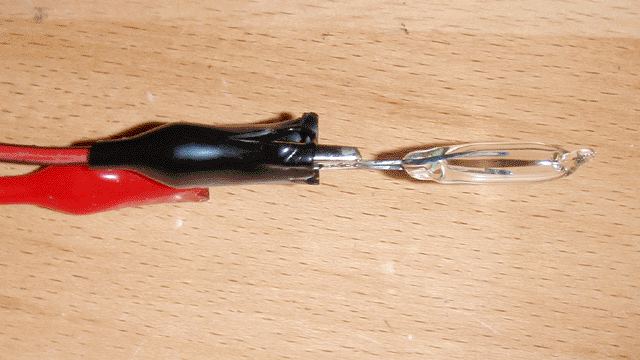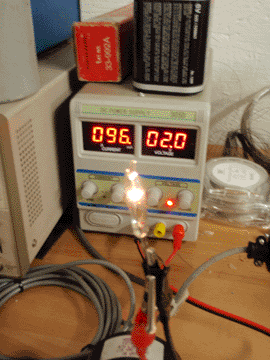

Before making a diode, I decided to make a light bulb that could run continuously without overheating. In order to do this, I needed either a thinner filament or a larger bulb; I chose to use a thinner filament, as this would make any future devices easier to run on batteries.
I started by purchasing a short length of .0006 inch (15 micrometer) tungsten wire. This is incredibly small, easily thinner than a human hair, and was barely visible as I was building the hairpin electrode assembly. The glasswork was the same as for the previous bulb, except I didn't blow a true "bulb" into the glass. I decided it wasn't necessary due to the reduced heat output of the new filament. I evacuated the bulb in the usual way, still using hot glue to seal the glass to the manifold. I found that by exposing the joint to vacuum while the glue is still molten, the glue gets sucked into any gaps and makes an airtight seal fairly easily. However, even with this improved seal, I still only reached a vacuum of 10 millitorr. This was only after a few minutes of pumping, though. For the next device I make, I will let the pump run longer.
I tested the bulb on my DC power supply and it produced a small, intense light when operated at around 2V and 100mA. This turned out to be running the filament too hot, however; when held at a constant 2V the current slowly dropped, and had reached 97mA before I disconnected the power supply and sealed off the bulb. The bulb had the same characteristics when turned on again, which indicates the seals were good. I let it run for another five minutes or so, and by that time the current had dropped to 93mA. When the bulb was turned off, I noticed a small dark spot on the inside of the glass near the filament, confirming my suspicion that the filament was evaporating. When powered on again, the filament flashed brightly at a point near the middle, and then went open-circuit.
Although it eventually failed, this bulb was a success in that the failure was due to an error in operation, not in construction. The thinner filament wire is certainly usable, and the titanium used for the feedthroughs has been exceptionally reliable in all devices, with no cracked glass or poor seals so far.